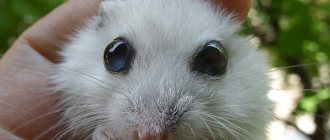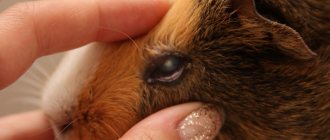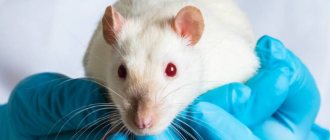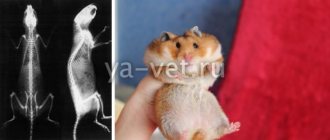The most common are the cute Djungarian and Syrian hamsters with long hair. Therefore, the red eyes of a hamster become quite unusual and repulsive for us. Some people who are not familiar with the distinctive features of the breed mistakenly assume that a hamster with red eyes has some kind of pathology and is sick. Don't rush to conclusions, you just need to figure it out.
Such animals are capable and produce healthy offspring. The main thing is to determine the cause of the rodent’s unusual eye color.
Albinos
Why do hamsters have red eyes? It happens that the most ordinary hamster parents give birth to a baby whose fur does not even have a hint of pigmentation. No type of color suits him. It is for such special animals that the name albino was created. Every species of rodent sooner or later encounters such unusual representatives. Albinos are also found among most creatures on Earth.
Such fluffies are considered very valuable, since genes are responsible for the presence of pigment, but its absence is a random and natural result. These little ones have red or pinkish eyes. In nature, such rodents have a hard time, since their white fur gives them away in a dangerous situation, so they do not live long. Well, in a cozy human house, hamsters feel calm and confident. The lifespan of pets is 3-4 years.
The health of albinos is quite fragile, which is worth remembering. The color of the coat and eyes are not the only differences from relatives; habits, character and size may also vary slightly.
Why the hamster...?
There are several reasons why rodents refuse to eat: 1. Clogged or inflamed cheek pouches, dental problems. 2. Poisoning. 3. Infectious diseases affecting intestinal function. Your actions: Examine the hamster yourself, pay attention to its droppings, change its diet, show it to a specialist. — Why does a hamster have yellow teeth? The tooth enamel of hamsters is not white, like that of humans, but yellowish. If the teeth are completely yellow, this may indicate that the animal is old or that the food the hamster eats contains dyes. — Why do the hamster have red eyes? This is a type of mutation that most often occurs in rodents with white and light fur. This is normal and does not require treatment.
Why the hamster...? Djungarian hamster Acrobatic. Vl. Krivosheev Alexander - Why does the hamster sleep all the time? Hamsters are nocturnal rodents, so they sleep almost all day. Sleep norm is 15-18 hours; if the hamster sleeps more, consult a doctor. — Why doesn’t the hamster drink water? If the hamster receives enough succulent food (fruits or vegetables), then it usually does not need water. But no matter what the hamster eats, there should always be fresh, clean water in the cage. — Why does a hamster squeak in its sleep? The squeaking may be from pain, or it may simply be uncontrollable sounds (not dangerous). Your actions: If the squeak is repeated constantly, then it is better to show the hamster to a doctor. — Why does a hamster eat its babies? There are several reasons for this: 1. Natural selection (cubs with various developmental defects, i.e. not viable offspring). 2. Lack of protein in the diet. 3. Young female (weak maternal instinct). 4. The mother and cubs are often disturbed (they pick up the cubs, look into the house, change the bedding ahead of time, etc.). Your actions: 1. Select a male more carefully (from another litter, not a close relative). 2. Increase the amount of protein in your diet. 3. Avoid getting pregnant too early. 4. Do not disturb the mother and her cubs. The bedding is changed on the 7-10th day of the cubs' life (you will have to endure the unpleasant smell). — Why do hamsters run in a wheel? Hamsters run on a wheel because they need movement and sometimes a cage alone is not enough for them. The wheel must be at least 18 cm in size and is intended specifically for hamsters. - Why do hamsters stink (smell)? An unpleasant odor can come from both the hamster and the bedding. If your hamster's urine starts to smell very strongly, then most likely he has kidney problems or a bacterial disease. An unpleasant odor can come from spoiled hamster food. Bad breath may be due to clogged or inflamed cheek pouches. Your actions: 1. Change the filler. 2. Change food. 3. In other situations, an examination by a specialist is necessary. - Why do hamsters fight? In nature, hamsters live alone. When two hamsters meet, a fight may occur, as the rodents defend their territory. If you introduce a newbie to a hamster, then a fight in such a situation is inevitable, because... the old-timer will defend his territory (cell) from the newcomer. If hamsters are left in a cage, sooner or later, the stronger one will bite the weaker one. Keeping several individuals (especially of the same sex) together in one cage is undesirable. — Why do hamsters bite? Hamsters can bite out of fear, as well as in defense. Imagine yourself in the place of a hamster. Without your consent, the giant roughly grabs you and begins to squeeze you. You'll like it? The same thing happens with a hamster. He squeaks and defends himself as best he can. Your actions: The hamster should be tamed gradually. Some individuals are not tamed immediately. Every animal has its own individual character. It may also be that your hamster will remain wild, no matter how hard they try to tame it. - Why can’t a hamster have cabbage? Hamsters should not be given cabbage due to the enzymes it contains. When cabbage is digested, an increased amount of gases is released in the intestines, which causes bloating and intestinal obstruction in the hamster. If bloated, give your hamster a couple of drops of dill water (sold in pharmacies for babies) or a decoction of dill seeds.
>Why do hamsters have red eyes?
Non-communicable diseases
Non-contagious diseases of Djungarian and other breeds of hamsters primarily include injuries. They are injured mainly due to the fault of their owners. Rodents should not be allowed to walk on a table or other surface from which the homa could fall. When purchasing and installing a running wheel, it is necessary to exclude narrow (less than 0.5 cm) gaps so that the baby does not stick his paw in there and injure himself. If you have several dwarfs, place them in different cages. Otherwise, they will fight and may also injure each other.
Poor nutrition may be the cause
- dental diseases;
- inflammation of the cheek pouches;
- food poisoning;
- hemorrhoids (if blood drips from the anus, your pet may have a fissure there).
Non-communicable diseases also include complications of pregnancy and pathological childbirth in females. Sometimes blood under the female's tail appears as a result of a miscarriage.
Metabolic disorders
Metabolism is the proper functioning of all body systems. Food processing, energy production, removal of unnecessary and harmful products. The central nervous system is responsible for all this, but the glands that secrete hormones have a huge influence on metabolic processes. These include the thyroid and pancreas, adrenal glands, pituitary gland, and gonads. Poor nutrition, poor environment, and hereditary factors affect the functioning of these organs. Violation of their normal functioning leads to a malfunction of the body as a whole. Diseases of Djungarian hamsters are often associated with metabolic disorders.
Diabetes mellitus can develop due to excessive consumption of carbohydrates. Hereditary predisposition to the disease also plays a role. You can find out that a hamster has contracted this disease by the characteristic smell of acetone, which comes from the rodent's saliva and urine. But only a doctor can make a final diagnosis by doing a blood test. Prevention of disease in Djungarian hamsters is a balanced diet, eliminating sugar from the diet, good care and an active lifestyle.
Stroke can also be classified as a disease that occurs due to metabolic disorders. With age and as a result of poor nutrition, cholesterol plaques are deposited on the walls of blood vessels, which prevent the normal passage of blood. At some point, the plaques completely block the vessel, it bursts, and hemorrhage occurs.
If your hamster is shaking or having convulsions, the end is probably near.
Sometimes attentive owners are concerned that the rodent has a yellow sore on its stomach. In fact, this is a scent gland, with the help of which the male marks his territory.
Other diseases in hamsters that may cause eye problems
Eye infections are not always the reason why a hamster’s eyes are watery or other problems with the organs of vision have appeared. Sometimes the problems are completely different, and eye discomfort is just a side effect.
For example, inflammatory processes in the cheek pouches. In this case, the cheek may become swollen and, as a result, the hamster's eye closes. In this case, there is no need to put drops in your eyes or smear them with ointment, it will not be effective. The cheeks should be cleaned; this should only be done by a veterinarian.
Another common problem is an abscess in the hamster as a result of a strong blow, bites from other rodents and the like. For example, a bump or swelling in the head area, if the blow lands there, can cause redness of the eyes.
It’s great if you notice swelling in the initial stages, in which case you can get by with taking antibiotics, but if this moment was missed, a purulent wound may develop. This problem requires more serious treatment, often surgical intervention.
Under no circumstances should you self-prescribe medications to an animal. Sometimes rodents may not tolerate certain medications, this will lead to fatal consequences.
Only after a complete examination of the animal can the veterinarian correctly prescribe treatment. Sometimes, it may be necessary to open and wash the wound, install drainage, and apply sutures. Sometimes the abscess opens on its own, then the doctor performs a slightly different series of manipulations, which also include washing and disinfecting the diseased area of the body.
Non-inflammatory diseases
Cataract
If your hamster's eye is cloudy, it could be a cataract - a metabolic disorder in the lens. The disease leads to
blindness. Eye drops are not effective, and surgery is not performed in either the Djungarian or the larger Syrian hamster. When the owner notices that the hamster's eye has turned white, this is a reason to consult a doctor, despite the fact that there is no treatment. Cataracts in a hamster are a sign of old age, decrepitude of the body, and in a dwarf or Campbell's hamster it is an indirect sign of diabetes. In both cases, treatment of the underlying disease is required to prolong the pet's life.
A thorn on the surface of the cornea is not a cataract, but the consequences of an injury, a scar. With cataracts, something light is visible in the depths, in the area of the pupil.
Glaucoma
An increase in intraocular pressure is accompanied not only by enlargement and bulging of the eyeballs, but also by severe pain. A doctor makes a diagnosis of glaucoma after measuring the pressure in the eye. It is not possible to normalize it with drops; the only treatment is enucleation to stop the pain. If you don't do anything, the eye will eventually burst. It is difficult to say why such a pathology occurs. Since Campbell's hamsters are most often affected, rarely Djungarians and never Syrians, a genetic (hereditary) nature is assumed.
Prevention of eye diseases
As you know, a disease is always easier to prevent than to treat.
By following some simple recommendations, you can reduce the risk of eye diseases in your pet to a minimum:
- Use a material for bedding that will not cause mechanical damage to the eyes and in which bacteria will not accumulate. Pet stores sell special litters; you can use odorless cat litter or wood litter.
- You should not keep many hamsters in one cage, as this can be dangerous.
- Separate from the rest of the hamsters those who have congenital diseases or are genetically predisposed to them.
- Do not place the cage in direct sunlight.
- Examine your pet's eyes regularly for signs of injury.
- Try to minimize or completely eliminate sweets from your diet.
How much does an Angora hamster cost?
You can buy a baby secondhand at bird markets and pet stores. A hamster with long hair costs on average 200-300 rubles. If you search well, look through the advertisements, perhaps they will give you a pet, because hamsters are very fertile. An Angora hamster is inexpensive, but to provide it with the proper conditions, you will have to spend money.
Hamsters live on average 1.5-4 years, during which time he must buy food and, if desired, vitamins and accessories.
A cage is the first thing you buy for a pet; you’re not going to keep it in a jar, are you? The fluffy hamster is not a participant in the reality show “Behind the Glass”. It will be uncomfortable for the baby there. The can is cramped, you can’t put a wheel and a cozy house for sleeping in it. The cage is well ventilated and easy to clean. The average price of a cage for an Angora is 600 rubles. If it is larger, then the price is correspondingly higher.
Treatment of disease in Djungarian hamsters
By contacting the Ya-Vet veterinary center, we will provide you with full qualified assistance, help you console yourself and cure your rodent, and you can also use the service of calling a doctor at home. The experience and professionalism of our specialists will satisfy all your requirements, and the price will pleasantly surprise you.
After a complete examination, the veterinarian may prescribe home treatment . Let's look together at what a hamster owner can handle on his own.
- If you have a cold , it is enough to give your hamster more fruits that contain vitamins; they, in turn, will stimulate the functioning of the animal’s immune system. Thus, with a minor cold, your hamster will return to normal in a couple of days.
- In case of eye disease, it is enough for the rodent owner to rinse the eyes with lightly salted water several times a day.
- In case of mechanical damage to the teeth or their shortening, you should contact veterinary centers for qualified help; in many cases, the diagnosis and its solution can only be made by a highly specialized specialist.
- Diseases of the skin and coat are varied; hair loss can be triggered by a state of shock, fear of the baby, or prolonged stress, pay attention to this. There may also be parasites on the skin of the animal - ticks and lice; special sprays and ointments will help us deal with this problem.
- For disorders of the gastrointestinal tract of the Djungarian hamster. It is enough to change his diet, pay attention to the foods he eats.
- If tumors and lumps , immediately contact a veterinary center, only there they will give you an accurate diagnosis and offer the right path to solving the problem.
- Constipation is treated by adding a drop of vegetable oil to the food; it softens the solid mixture and forms a soft effect on the walls of the stomach. Also, the addition of fiber (fruits, vegetables) will accompany you on the way to a good passage of the intestinal tract.
- Allergies in a hamster can be caused by unsuitable food, sawdust in the cage, or bedding materials.
- Molting is treated by normalizing nutrition, including vitamin-rich foods in the diet and adding yeast to the water.
- If you have an obese hamster , then treatment is completely in your hands; the right diet and exercise will get your pet in shape.
What to feed white hamsters?
Foods high in carotenoids are beneficial for the health of hamsters. The rodent's diet should be balanced, varied and include the following products:
- Fresh vegetables. Carrots, beets, zucchini and pumpkin are suitable for hamsters.
- Fruits. Apples and pears contain substances necessary for the health of jungarians. Gnawing hard fruits, the animals wear down their incisors.
- Fresh greens. Dill, parsley, lettuce, clover and spinach can be given individually or made into a luscious herbal mixture.
- Nuts. Hazelnuts and peanuts are beneficial for rodents; almonds are hazardous to health.
- Specialized feed. You can find them at a pet store, or you can prepare them yourself. To do this, mix buckwheat, lentils, wheat, corn and rolled oats.
- Protein food. Chicken meat, shrimp, boiled eggs, as well as small insects should be present in the animal’s diet.
Albinos should not be fed fatty or fried foods. Spicy and salty foods are contraindicated for them. Feed the animal at least twice a day, pouring dry and fresh food into different bowls.
Differences in appearance
The Djungarian hamster and the Campbell's are very similar. They have approximately the same weight and size and can mate with each other, so it is likely that a pet store may sell hybrids that have characteristics of both species. But still, each type has its own differences.
By coat type and color
The greatest differences between these types of hamsters are external.
Distinctive features of dzhungariks:
- White belly and arches on the sides, which are called vaults.
- There is no pattern on the fur other than its natural one.
- Smooth dense fur.
- But on the head there is a darkening of the fur in the form of a diamond. There are also dark spots on the sides.
- The base of the hair on the abdomen is white.
Did you know? Hamsters are one of the few animals that already have teeth at birth. Rodents' teeth grow throughout their lives, so the animal must constantly grind them down. Based on color, Djungarian hamsters are divided into :
- brown-gray with white belly (standard);
- white-gray (pearl);
- gray-blue with a white belly (sapphire);
- red-cream (mandarin).
Two types of hamsters have a dark stripe on their back, but in the Djungarian it is wider. Winter molting is also typical for animals of this species. This process depends on the length of daylight hours. As soon as the days become short, over the course of 6 weeks the dzhungarik changes color to almost white. This is due to the production of the hormone melatonin.
Did you know? Male Campbell's hamsters help females during childbirth: they remove the cubs, clean the newborn's nostrils, and carry them to the nest. If the female leaves the nest, they remain to look after the offspring.
Distinctive features of Campbell's hamsters:
- Some individuals of this species also have arches, but they are not as clearly defined as those of the Dzungarians.
- The fur is more protruding because it grows at a greater angle to the body.
- The color is mainly red, but they can be of various colors: from white to black. In nature, the coat color is dark gray with brown areas.
- On the back the dark stripe is narrower, but more clearly defined. There is no darkened diamond on the sides and head.
- The base of the hair on the abdomen is gray.
- Does not change coat color for the winter.
Dimensions
The size of individuals of the two species is the same - 7–10 cm in length, the weight of an adult rodent is 60–70 g. Since the size of the animal is small, it can live in a small cage or a small aquarium.
Body type
The Djungarian hamster is shaped like an egg. The line of his head flows smoothly into his nose. Campbell's hamster's body is shaped like a figure eight. That is, this species has a pronounced waist. Their nose looks like a small bump. An animal of this species has smaller ears.
Did you know? Campbell's hamsters were named after a member of the British consular service in China, Charles William Campbell.
Eye color
The eye color of hamsters is mostly black. But it is possible to meet healthy animals with red and ruby eyes. These are mainly white and ivory rodents. An animal inherits eye color depending on dominant or recessive alleles. Sometimes an ordinary couple gives birth to a completely white baby with red eyes. This is an albino. For rodent breeders, such a specimen is very valuable, since the absence of the melanin pigment is not transmitted by genes, but is obtained by chance.
Color
The first thing you should pay attention to when purchasing a small rodent is the color of its coat. Let's look at every color detail that helps determine the rodent breed.
Dzhungarik's wool is colored in dark shades of brown, black and gray. The fur of its dwarf relative is colored in sand and amber shades; there are also black representatives of the species. If Djungarian hamsters are dark brown, the Campbell hamster has light shades of brown. In 99% of cases, Dzungarik has a diamond on his head. Depending on the color of the coat, it can be clearly outlined or almost merge with the main color of the coat. It is most clearly drawn on the head of brown rodents. In gray animals it is barely visible. Look at your pet's sides. Dzungariks have clearly defined arches between their back and stomach. The Campbells also have them, but their outlines are not so pronounced
They practically merge with the main color of the coat. The last thing to notice is the stripe on the back of the pygmy rodent. It is present in both breeds, but in Dzungariks it has clear boundaries, and it is also quite wide at the withers.
The Campbell's hamster has a thin dorsal stripe, almost invisible in the lower part of the body.
Campbell rodents come in a wider variety of colors. Among the pets there are albinos, animals with Argentine and Agouti colors, spotted and gray rodents, etc.
Eye care for hamsters
There are rules that, if followed, will help owners minimize the risk of ophthalmic problems in hamsters. These include:
- regular inspection of animals;
- immediately contact a veterinarian if eye pathology is detected;
- trimming the hair around the eyes of representatives of long-haired breeds of hamsters;
- use of high quality bedding material;
- regular change of litter as it gets dirty;
- timely treatment of infectious diseases.
It is very important not to leave the hamster's cage in direct sunlight, as this can also lead to blindness. If the animal has the opportunity to walk freely around the apartment, then you should ensure that there are no drafts and that surfaces are clean, even in hard-to-reach places.
How to treat
It is imperative to treat conjunctivitis in a Djungarian hamster, otherwise the animal risks dying from the infection. There are several proven, effective remedies for home treatment. The first is Albucid eye drops.
If after three days of treatment your pet does not feel better, you should definitely contact a veterinarian. Delay in this case can lead to the death of the animal.
They are used as follows: 1 drop of solution is dripped into each eye of the animal (even if inflammation is present in only one, both need to be instilled). The frequency of the procedure is 3 times a day. With positive dynamics, improvement occurs on the third day of treatment.
How to wipe and treat the eye
How often to rub the eyes depends on the rodent owner. For this manipulation, moisten a cotton pad with Albucid and carefully remove the remaining pus near the pet’s eyes. This wiping is performed in parallel with instillation, but once a day will be quite enough. It is not advisable to use other means, since, given the small weight and fragility of the hamster’s health, it is difficult to predict how the drugs will affect its condition.
Rules for caring for albino hamsters
Caring for snow-white hamsters is almost no different from caring for other rodents. But there are several features in their content that should be taken into account so that the pet feels calm and comfortable:
- Animals with white coats do not like to be close to other hamsters, so it is advisable to keep them in a separate cage. This is especially true for miniature albino jungarians, who often show aggression towards other rodents;
- The owner will have to frequently change the bedding in the pet’s home to prevent infection from entering the animal’s sensitive eyes;
- Cage size is also important when keeping these unusual animals. The cage should be spacious and equipped with a running wheel, shelves at different levels and a swing;
- Snow-white rodents love secluded places where they can hide from everyone. For example, the albino Syrian hamster needs a house in which it spends most of the daytime, escaping the light and sun;
- Hamsters with snow-white fur should not be bathed. To make their coat look well-groomed, just put a bath with special sand in the cage;
- These animals are very shy, so it is necessary to protect them from noise and loud sounds. It doesn’t matter what breed your pet is, a miniature Djungarian hamster, or a fluffy snow-white Syrian, the main thing is to devote enough time and attention to your unusual pet, because each of them needs the love and care of the owner.
Causes of red spots around the eyes
Sometimes it happens that it is not the eyes themselves that become red and swollen, but only the skin around them. What are the causes of red spots around the eyes? In many ways, predisposing factors are in one way or another associated with other ophthalmological diseases:
- Very often, redness of the skin is explained by the irritating effect of the inflammatory exudate that flows from the eyes during conjunctivitis.
- In addition, many eye pathologies are characterized by severe itching and other unpleasant sensations, due to which the animal constantly rubs its eyelids and the skin around them with its paws. Simply put, redness is a consequence of rubbing and scratching.
Tumors and neoplasms
Tumors (malignant, benign), pathological growths on the body, legs. ears is a fairly commonly diagnosed pathology in rodents, which can develop for a variety of reasons. Bumps can appear due to injuries, severe bruises, or falls from a height. To begin treatment, you need to establish a diagnosis, so take your pet to a veterinarian.
For benign and malignant tumors, surgical treatment will be prescribed. If the cancer is localized in a hard-to-reach area (oral cavity), the tumor has metastasized, veterinarians recommend euthanizing the patient.
Life expectancy of albinos
The white hamster with red eyes is found in every breed of rodent. Hence the different life expectancies of albinos.
- Djungarian hamsters live for about two to three years. Some individuals live for four years.
- The lifespan of a Syrian is three years. There are rodents that live up to six years.
- Campbell's species rarely lives for more than two years.
- The lifespan of a Roborovsky hamster is two and a half years.
- The shaggy dwarf rodent rarely lives more than two years.
The lifespan of a snow-white animal depends not only on the breed, but also on the conditions of detention, nutrition and care. If you feed your pet high-quality food, show it to the veterinarian on time, and keep the cage clean, then its life expectancy increases.
Albino hamsters with red eyes
The “classics” are albino hamsters with red eyes. In their case, the red color of the cornea is absolutely normal and does not pose any danger to the health of the animal. This color is due to the fact that blood vessels are visible through the pigment-less cornea.
It is generally accepted that animals with red eyes are necessarily blind from birth, but this is not at all true. In most cases, “red eyes” do not have problems with vision. Moreover, blindness is weakly associated with eye color. If blind animals regularly appear in the litter of animals, then such producers should be excluded from the reproduction process due to the presence of some defective genes.
Breed characteristics
You need to start with one simple fact: red eyes in hamsters do not in all cases indicate an illness in the animals.
Moreover, many breeds of rodents have such eyes initially (more precisely, this is a consequence of selection work). In these cases, “redness” is just breed characteristics:
- Campbell's hamsters. Not all of them, but only some color varieties (light, including sandy and amber).
- Many other hamsters with gray, brown, white coloring, as well as in the “ivory” variants, have red eyes.
There are exceptions too. For example, among “jungarians” this coloring of the cornea is not found at all, with the exception of albinos. However, it is impossible to describe all possible breed variations within one article. If there are doubts related to the coat color and eye color of the animal, consultation with an experienced breeder is necessary.
In particular, there is a classic situation when the same Campbell hamsters are passed off as Djungarian hamsters. So, if in the first case animals have red eyes and this is allowed by breed standards, then in principle Djungarians cannot have red eyes.
List of necessary things for an animal
For a comfortable life for an albino hamster, the necessary minimum of things must be present in its cage, namely:
- Bedding, which can be simple sawdust. The hamster will be able to move around somewhat, in addition, they are safe for health;
- The hamster needs a house as a personal space where he can retire and hide from the light;
- In order to wean your pet from using the toilet in a cage, you need to place a special container that can be easily purchased at a pet store;
- Mineral stones will help your rodent grind his teeth easily. For such purposes, you can purchase a mineral type stone. If you have doubts about your choice, you can consult a sales consultant.
When purchasing equipment for rodents, it is important to remember that the cage must contain more than just the listed minimum. Rodents need exercise equipment to stay active. For such purposes, the following options for simulators for cells of different sizes are suitable:
- wheel;
- hammock or tunnel of varying complexity;
- snags and branches on which it will be convenient for the rodent to climb.
If the rhythm of life of the animal owner does not provide for a nighttime wakefulness, then it is not recommended to place a cage in the bedroom. Hamsters are active at night and their noise will disturb the owner's rest.
Experts recommend covering the bottom of the cage with granular filler. Cotton wool and sawdust are not suitable in this case; the rodent will get its paws stuck in them, which will complicate movement. If you use sawdust, it will scatter around the room from the cage. Care for this type of rodent must be of high quality and timely. Otherwise, the owner’s negligence can lead to illness in the animal.
For the same reason, you should try to monitor the quality of the water in the drinking bowl and change it in a timely manner. It is worth periodically changing the contents of the house. If the hamster’s food, which he carries there by nature, begins to rot there, then the animal may simply be poisoned.
Bathing pets in water is strictly prohibited. Their delicate bodies react negatively to sudden temperature changes. The natural behavior of rodents is facilitated by their natural wool cleaning skills. For a bath, some owners leave river sand filler in the cage.
Other diseases typical for pets
Often the reason that a hamster lies, does not move, does not eat, does not drink, but breathes, is infectious and viral diseases.
In such cases, it is advisable to pay attention to additional signs, since in the absence of timely medical assistance, the hamster may die
Pneumonia
Pneumonia, or “pneumonia,” can occur if the cage has been left in a draft or in a cool, humid room, such as a bathroom, for a long time. Additional signs of its development, in addition to frequent breathing, are:
- wheezing, gurgling in the lungs, which can be heard without additional equipment;
- presence of nasal discharge;
- lack of physical activity, lethargy;
- lack of appetite.
In such cases, it is best to call a ratologist, because the animal will need intensive injection therapy for 10-14 days. Only a specialist can prescribe medications. However, rapid breathing can cause heart failure. Upon examination, only a veterinarian will be able to indicate the real reason for this behavior.
Agony
If the hamster lies motionless, his eyes are open, and his breathing is heavy, he is most likely in his death throes. This often occurs after the animal falls ill a few days before the onset of such a condition. It’s a pity that if the hamster is breathing heavily and lying on his back, most likely there is no way to help him. An experienced veterinarian will suggest performing a euthanizing injection in such cases.
To make sure that the baby is really in agony, you need to remember whether he had diarrhea in the last 24 hours, whether his stomach suddenly increased in size and whether the pet lost weight. Hamsters cannot get sick for a long time because their metabolism is too fast. For this reason, you should immediately call a veterinarian or go to him for an appointment yourself, because hamsters “burn out” literally in a day or two.
Serious concerns
It happens that the owner knows for sure: his animal is not an albino, and its coat color clearly cannot be attributed to the “white” or “ivory” subspecies. Sometimes the eyes used to be a normal black color, but suddenly they themselves or the skin around them began to acquire an uncharacteristic red tint. Then the question “why does a hamster have red spots around its eyes” requires a more thorough check and a mandatory search for a truthful answer.
Unfortunately, hamsters, like other animals, are susceptible to various types of diseases. There are a number of ailments that affect the eye organ either symptomatically or directly. Because of them, the eyes can take on a strange color.
The most obvious answer is blindness. It can be congenital or acquired as a result of injury. It is easy to recognize a blind hamster when purchasing: just carefully observe its behavior and communication with its fellows. The baby will lie in one place and move little. Sometimes pus or signs of swelling may appear in the eyes. In such cases, you should immediately contact a veterinarian, because perhaps the disease is still at an early stage and vision can be saved.
There may be other complications besides blindness. A hamster's eyes are bulging, which can allow infection to enter them. If the animal ran freely around the room and collected a lot of dust, it is quite possible that it contracted conjunctivitis. It can also appear due to the laziness of the owner, who rarely changes the bedding in the cage and does not do general cleaning. The main symptoms: white or gray discharge from the eyes, eyelids are wet, stuck together, swollen and red, the animal moves little and sleeps a lot.
In such cases, it is best to contact a specialist and not try to cure the hamster yourself. However, if this cannot be done quickly, you can maintain the condition on your own. It is necessary to isolate the sick animal, clean its cage completely, and treat it with antiseptic solutions or potassium permanganate. Buy eye drops that are harmless to this type of animal and apply 3-5 times a day depending on the severity of the infection. It would also be a good idea to put your pet on a diet: only natural grains and low-fat chicken meat without additives.
What should you be wary of?
Hamster diseases can also answer the question - why does a hamster have red eyes. This applies to animals that do not initially have white fur, so it is necessary to take your pet to a veterinarian for examination.
In this case, treatment is most often required, because redness and swelling may indicate not only mechanical irritation, but also be a manifestation of diseases of other organs.
An obvious ailment is the animal's blindness - congenital or acquired. It can be diagnosed independently: the rodent moves little, and the eyes fester or swell. If you consult a doctor at the initial stage, vision can be restored with medication.
But this is not the only danger. The protrusion of the eyes of these animals causes infections to enter the body. Even walking through a dusty room or living in unkempt cages for hamsters causes conjunctivitis.
- eye redness and swelling;
- purulent discharge;
- drowsiness and lethargy of the animal.
Self-treatment without a medical examination can only worsen the situation. It is better to take care of your pet using other methods: clean the cage and wheel with antiseptic solutions and provide proper nutrition (whole grains and chicken meat). Use special eye drops at the prescribed time as prescribed by your veterinarian.
Here they are - breeds of hamsters with red eyes. If you were wary of them before, now you know that this is a rare gift, and you will be lucky enough to become the owner of an albino.
In scientific terms, albinism is a mutation in the body that is characterized by the absence of a special pigment in the cells of the skin, fur and eye shell (popularly known as melanin). Representatives of rodents of any breed can become albinos. To provide quality care to such special babies, you need to better understand the nuances of their body structure.
In the wild, there are hamsters of a wide variety of colors, ranging from black to unusual golden shades of fur.
Due to the fact that the white color of the fur coat too clearly attracts the attention of large predatory animals, it is quite rare in nature. A snow-white rodent may be a Djungarian, a Syrian, or a representative of another, less common breed of hamster
Breeders have put a lot of effort into developing a breed of hamster with a perfectly white coat. Attempts for a long time were unsuccessful, and when crossed, the offspring were too weak to survive. After a little time, the breeders were still able to breed an individual that met all the necessary criteria.
Pedigree snow-white hamsters are very popular among experienced breeders. At the same time, a rare coat color can be a consequence of both albinism and animal selection. This is a kind of mutation, as a result of which the previously mentioned melanin is absent in the animal’s cells. The animal's famous red eyes are also the result of a genetic mutation.











